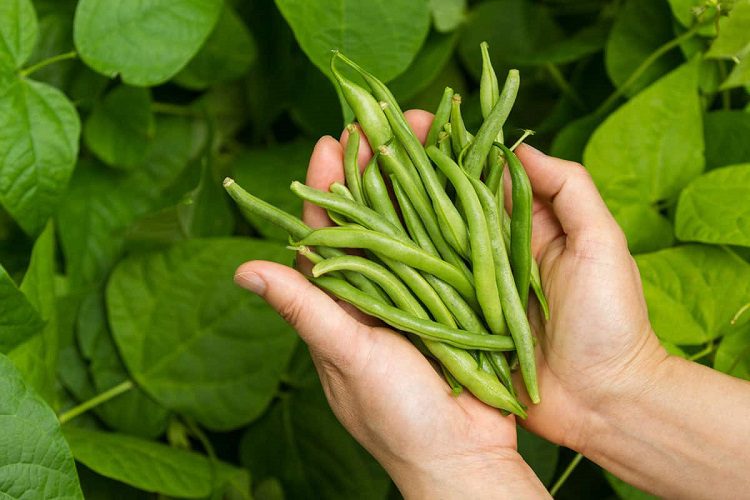Exploring the options in how to grow beans may be new to you, or you may already have this knowledge.
Whatever the case, you can produce many different bean varieties such as pole or bush beans.
Beans require little maintenance, contain many health benefits, and are worthy of further exploration as a gardener.
Add to your vegetable patch with these non-fussy plants to extend your organic food source, whether you choose to grow beans in containers or raised garden beds.
Why Growing Beans Benefits Your Health

Other than the therapeutic benefits of growing beans, these simple plants come in many varieties. In addition, bean varieties come in different forms, such as shelling beans, dry beans, and snap beans.
These beans are highly nutritious and contain loads of goodness such as potassium, magnesium, folate, iron, fiber, and protein. Beans are also low in carbohydrates, making them an excellent food choice for anyone who wants to lose weight.
You can source various bean types, including black, kidney, navy, pink, and pinto beans.
These varieties represent a small number of the kinds of beans you can grow in your garden. Others are known as peas but are actually beans and include blackeye peas, cowpeas (southern peas), crowder peas, and many more.
The health benefits of these beans are quite phenomenal, as they are for many other vegetables or legumes. Eating beans and the nutrients they contain can lower the risk of certain diseases developing, such as:
- Obesity
- Heart disease
- Certain cancers
- Neural tube defects in infants
- Reducing the volume of low-density lipoprotein (LDL) cholesterol
- Diabetes
- Metabolic syndrome
- Stroke
- Hypertension
- Gastrointestinal diseases
As part of the legume family, beans are also low in sodium and contain little or no fat, which is ideal for heart health. Beans also have high fiber content, making them an excellent choice for the digestive system.
You can choose to plant beans indoors or outdoors for a regular supply of scrumptious organic food. You can also select which types of beans you want to grow to add to your daily dietary needs. Whichever bean variety you plant, you are assured of a rich source of natural nutrition.
When To Plant Beans

How to grow beans means knowing when and where to plant them. You should grow beans outdoors following the last date for spring frost.
By this time, the earth will be warm enough at around 48°F to support germination. Plant beans before this time and the soil will be too cold, and the seeds will die.
It is near impossible to grow beans indoors unless you have a greenhouse. Beans have delicate root systems, so they do not transplant well. Also, beans proliferate, so there is little point in beginning seed growth indoors.
Decide whether you wish to plant pole beans or bush beans. Pole beans are climbers extending to 15 feet, so you will need supports to grow these plants. In contrast, bush beans grow in compact bushes, so they do not require height support. However, they do occupy quite a lot of surface space.
Like most plants, pole and bush beans have their up and downsides. While it is easier to grow bush beans, pole beans typically produce higher yields. Bush beans also require less maintenance, but pole beans possess a greater resistance to diseases.
Bush beans also mature more rapidly than pole beans at 55 days compared to 65 days (not much difference).
Another growing feature to be aware of is that bush beans tend to mature simultaneously, so it is best to stagger planting to take advantage of regular harvesting.
In contrast, you can continue harvesting pole beans to boost growth so that you can enjoy the crop for a couple of months after they mature on the vine.
Container Or Raised Bed
You can use both containers and raised beds to know how to grow beans in small or larger spaces.
If you choose to plant green beans in containers, they must be a minimum of 15 inches across to provide enough growing space. The container should also be at least 9 inches deep to support green bean growth. In addition, green beans will need pole support or a trellis to support their weight as they grow.
If you prefer planting bush beans, then choose a container about 18 inches wide and long as they tend to spread. Choose a container that accommodates more than 7 inches of depth and caters to the roots of these plants.
Any container you use should have enough drainage holes at the bottom to prevent the bean roots from lying in too much moisture. Excessive watering causes root rot, which will destroy the plants.
If you have a five-gallon container, you may have enough room to grow pole and bush beans. However, unless you can space the seeds at least 2.5 to 3 feet apart, rather plan how to grow beans in a raised bed. Typically, raised beds provide more room for bean growing.
When you plant beans in a raised bed, ensure that you bury the seeds about an inch deep in the soil. If the soil is sandy, plant them a little deeper.
Also, leave up to two inches between bush beans, so they have room to spread. When planting bush beans in rows in raised beds, ensure you leave at least 18 inches between them.
Similarly, planting pole beans in raised garden beds also require growing room. First, insert the poles or a trellis in the ground before planting the seeds, as disturbing them after planting may negatively affect their growth.
Plant pole beans an inch deep, leaving a minimum of three inches between each seed.
If you choose to create a triangular shape of sticks for pole beans to climb, then you can plant three to four seeds around each pole in a raised garden bed. As the green beans grow, secure the vines to the poles with string for additional support.
Although green beans need at least six or eight hours of direct sunlight daily, the blossoms will wilt and die if the weather is too hot. Therefore, it is best to protect the flowers from high temperatures with row covers.
Soil To Use

Part of finding out how to grow beans equates to proper soil preparation. Fortunately, beans are not too fussy about the soil in which they grow as they produce their own nitrogen.
Despite not being fussy growers, beans do better in soil that is either neutral or slightly acidic.
Therefore, test the soil pH before planting to ensure that it is between 6.0 and 7.0. To amend the soil to this level, use well-aged manure or mulch with compost during the fall before planting. Otherwise, prepare the ground before spring planting.
Mulching ensures that you keep these plants cool in the summer months because they have shallow root systems. Mulching also helps to maintain excellent drainage.
Ensure excellent soil drainage to prevent mildew from forming on these plants.
How Often To Water

You should water the beans regularly, providing them with at least two inches of water for each square foot every week. Neglecting watering will prevent beans from flowering and producing fruit.
If the weather is scorching, water the beans early to have enough time for the leaves to dry. Leaving beans with soaking wet leaves promotes disease development, which will ruin your plants.
Also, in hot weather, cover your plants with row covers. Weed regularly, too, but be cautious not to disturb the bean’s roots. One more issue is breaking off the vines’ tops when experimenting with how to grow beans, which promotes pod development.
Fertilizer
You won’t need to use any nitrogen fertilizer when discovering how to grow beans–they produce their own. However, if you do get a general fertilizer containing nitrogen, it will simply feed the leaves of this plant instead of the pods.
When you decide to fertilize your beans, do it after they produce a luscious abundance of blooms and pods. This activity will ensure that the beans produce an excellent harvest.
Instead of using a store-bought fertilizer, you may want to consider feeding beans with aged manure or well-rotting compost. Composting is generally better for growing beans than other soil amendments and will give you the results that you seek.
Compost the beans about fifty percent into their growth phase, so they generate an excellent harvest.
Pro Tips
Pro tips when discovering how to grow beans are always helpful if you’re not familiar with cultivating these plants.
Pro-tip #1: To support bean growth, use a plastic bag under the soil, whether planting in containers or raised beds. This method will help heat the ground before you sow the seeds, which supports their germination.
Pro-tip #2: Instead of using a teepee-like structure to support pole beans, you can use what is known as a cattle panel. Cattle panels consist of wire fencing, which is portable. Cut the wire to approximately 16 feet in length and five feet high. Using a cattle panel helps growing vines and helps you when harvesting the beans. In addition, with a cattle panel in place, you won’t run the risk of stepping on the bean’s delicate root system.
Conclusion
Investigating how to grow beans is a worthwhile pursuit. Plant pole or bush beans, provide them with minimum care and enjoy the harvest.
Grow your beans in containers or raised garden beds, add a little compost, and watch the magic happen.
Adding alternative greens like pole beans to your diet increases your food options. Also, bush beans and pole beans are a healthy source of nutrition for people, so experiment with your options because there are many.
Resources:
